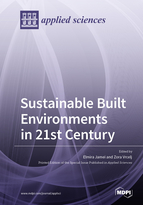Sustainable Built Environments in 21st Century
A special issue of Applied Sciences (ISSN 2076-3417). This special issue belongs to the section "Environmental Sciences".
Deadline for manuscript submissions: closed (30 October 2021) | Viewed by 54012
Special Issue Editors
Interests: sustainable built environment; smart cities and urban informatics; urban climatology and thermal balance; environmental urban planning and public health
Interests: sustainability of structures; sustainable materials; green buildings and infrastructure; use of waste in construction materials; digitalization in construction; structural stability; structural mechanics; biomimicry
Special Issues, Collections and Topics in MDPI journals
Special Issue Information
Dear Colleagues,
Sustainable Built Environments aim to achieve unprecedented levels of ecological balance, through new and retrofit construction and built environment especially in 21th century when rapid level of urbanization and population growth are inevitable. To create spaces with both long-term viability and humanization, we merge the natural, minimum resource conditioning solutions of the past, with the innovative technologies of the present and consider both environmental and social impacts. This may include land use, biodiversity damages, urban climate, energy consumption, carbon emission, material, water consumption, social inclusion, public health, and other impacts.
The focus of this Special Issue will be researches related to the innovative approaches and solutions of sustainable built environment, including design, construction, urban design, assessment models, case studies, and best practices analyses or their limitations.
Dr. Elmira Jamei
Dr. Zora Vrcelj
Editors
Manuscript Submission Information
Manuscripts should be submitted online at www.mdpi.com by registering and logging in to this website. Once you are registered, click here to go to the submission form. Manuscripts can be submitted until the deadline. All submissions that pass pre-check are peer-reviewed. Accepted papers will be published continuously in the journal (as soon as accepted) and will be listed together on the special issue website. Research articles, review articles as well as short communications are invited. For planned papers, a title and short abstract (about 100 words) can be sent to the Editorial Office for announcement on this website.
Submitted manuscripts should not have been published previously, nor be under consideration for publication elsewhere (except conference proceedings papers). All manuscripts are thoroughly refereed through a single-blind peer-review process. A guide for authors and other relevant information for submission of manuscripts is available on the Instructions for Authors page. Applied Sciences is an international peer-reviewed open access semimonthly journal published by MDPI.
Please visit the Instructions for Authors page before submitting a manuscript. The Article Processing Charge (APC) for publication in this open access journal is 2400 CHF (Swiss Francs). Submitted papers should be well formatted and use good English. Authors may use MDPI's English editing service prior to publication or during author revisions.
Keywords
- Sustainable smart cities
- Urban Planning and public health
- Sustainable Landscapes
- Sustainable construction and Building Information Modelling (BIM)
- Urban climatology and thermal balance
- Biodiversity in Cities
- Water sensitive urban design
- Regenerative Development and Design
- Renewable energy in Built Environments
- Sustainable building materials
- Waste management
- Intelligent Buildings Assessment
- Sustainability Performance Simulation Tools for Building
- Biomimicry for an Innovative Built Environment
- Social inclusion and universal design
- Sustainable housing practices







